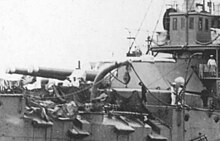| Type 41 12-inch 40-calibre BL 12-inch Mk IX gun | |
|---|---|
 Forward guns of Fuji | |
| Type | Naval gun |
| Place of origin | United Kingdom, later licence-produced in Japan |
| Service history | |
| In service | 1900–1945 |
| Used by | Royal Navy Imperial Japanese Navy Regia Marina |
| Wars | Russo-Japanese War World War I |
| Production history | |
| Designer | Elswick Ordnance Company |
| Designed | 1898 |
| Manufacturer | Elswick Ordnance Company Vickers Woolwich Arsenal |
| Specifications | |
| Mass | 49 long tons (50 t) |
| Barrel length | 40-foot-5-inch (12.32 m) bore (40 calibres) |
| Shell | 850 pounds (390 kg) separate charges and shell |
| Calibre | 12 inches (305 mm) |
| Breech | Welin interrupted screw |
| Elevation | −5/+15 degrees |
| Traverse | +150/−150 degrees |
| Rate of fire | 1 round per minute |
| Muzzle velocity | Japanese service : 2,400 ft/s (732 m/s) UK service: 2,481 ft/s (756 m/s),[1] 2,612 ft/s (796 m/s) (King Edward VII class) |
| Effective firing range | 15,000 yards (14 km); 15° elevation |
The Armstrong Whitworth 12-inch naval gun of 40 calibres length was designed by and manufactured mainly by Armstrong's ordnance branch, Elswick Ordnance Company. It was intended for the Royal Navy's Royal Sovereign-class battleships, but budgetary constraints delayed their introduction. The first units were instead supplied to Japan. As the Type 41 12-inch (305 mm) 40-calibre naval gun it was the standard main battery on several early United Kingdom-built pre-dreadnought battleships of the Imperial Japanese Navy.
It later entered service with the RN as the 12-inch Mark IX, being fitted to warships of three pre-dreadnought classes prior to World War I. Also, during the war several guns were converted for use as railway guns, and, towards the end of the conflict, for use on the M-class submarine monitors.
The gun also saw service with the Italian Regia Marina, in two classes of pre-dreadnought battleships.
- ^ 2,481-foot-per-second (756 m/s), 850-pound (390 kg) projectile, with 211 lb (96 kg) cordite Mk I size 50 & 3¾. Text Book of Gunnery, 1902.